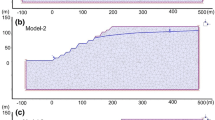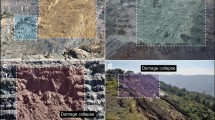Abstract
The rigid body limit equilibrium method (RBLEM) and finite element method (FEM) are two widely used approaches for rock slope’s stability analysis currently. RBLEM introduced plethoric assumptions; while traditional FEM relied on artificial factors when determining factor of safety (FOS) and sliding surfaces. Based on the definition of structure instability that an elasto-plastic structure is not stable if it is unable to satisfy simultaneously equilibrium condition, kinematical admissibility and constitutive equations under given external loads, deformation reinforcement theory (DRT) is developed. With this theory, plastic complementary energy (PCE) can be used to evaluate the overall stability of rock slope, and the unbalanced force beyond the yield surface could be the identification of local failure. Compared with traditional slope stability analysis approaches, the PCE norm curve to strength reduced factor is introduced and the unbalanced force is applied to the determination of key sliding surfaces and required reinforcement. Typical and important issues in rock slope stability are tested in TFINE(a three-dimensional nonlinear finite element program), which is further applied to several representatives of high rock slope’s stability evaluation and reinforcement engineering practice in southwest of China.
Similar content being viewed by others
References
BISHOP A W. The use of the slip circle in the stability analysis of slopes [J]. Geotechnique, 1955, 5(1): 7–17.
DUNCAN J M. State of the art: Limit equilibrium and finite-element analysis of slopes [J]. Journal of Geotechnical Engineering-ASCE, 1996, 122(7): 577–596.
ZHU Jian-feng, CHEN Chang-fu. Search for circular and noncircular critical slip surfaces in slope stability analysis by hybrid genetic algorithm [J]. Journal of Central South University, 2014, 21(1): 387–397.
CHEN Zu-yu, WANG Xiao-gang, YANG Jian, JIA Zhi-xin, WANG Ye-jie. Rock slope stability analysis: Theory methods and programs [M]. Beijing: China Water Power Press, 2005: 519–522. (in Chinese)
LAOUAFA F, DARVE F. Modelling of slope failure by a material instability mechanism [J]. Computers and Geotechnics, 2002, 29(4): 301–325.
GRIFFITHS D V, LANE P A. Slope stability analysis by finite elements [J]. Geotechnique, 1999, 49(3): 387–403.
CUNDALL P A, STRACK O D L. A discrete numerical model for granular assemblies [J]. Geotechnique, 1979, 29(1): 47–65.
ZHANG Chu-han, PEKAU O A, JIN Feng, WANG Guang-lun. Application of distinct element method in dynamic analysis of high rock slopes and blocky structures [J]. Soil Dynamics and Earthquake Engineering, 1997, 16(6): 385–394.
KAWAI T. New discrete models and their application to seismic response analysis of structure [J]. Nuclear Engineering and Design, 1978, 48: 207–229.
ZHANG Jian-hai, HE Jiang-da, FAN Jing-wei. Static and dynamic stability assessment of slopes or dam foundations using a rigid body-spring element method [J]. International Journal of Rock Mechanics & Mining Sciences, 2001, 38(8): 1081–1090.
SHI Gen-hua, GOODMAN R E. Generalization of two-dimensional dis-continuous deformation analysis for forward modeling [J]. International Journal for Numerical and Analytical Methods in Geomechanics, 1989, 13(4): 359–380.
SHI Gen-hua, GOODMAN R E. Two dimensional discontinuous deformation analysis [J]. International Journal for Numerical and Analytical Methods in Geomechanics, 1985, 9(6): 541–556.
LIU Jian-guo, SUN Qi-cheng, JIN Feng, LIU Qing-kai. Studies on structural and mechanical properties under isostatic compression with large-scale discrete element simulations [J]. Acta Mechanica Solida Sinica, 2014, 27(2): 129–136.
YANG Qiang, LENG Kuang-dai, CHANG Qiang, LIU Yao-ru. Failure mechanism and control of geotechnical structures [C]// Constitutive Modeling of Geomaterials. Berlin, Heidelberg: Springer, 2013: 63–87.
ZHENG Hong, THAM L G, LIU De-fu. On two definitions of the factor of safety commonly used in finite element slope stability analysis [J]. Computers and Geotechnics, 2006, 33(3): 188–195.
LIU Yao-ru, HE Zhu, LENG Kuang-dai, HUANG Yue-qun, YANG Qiang. Dynamic limit equilibrium analysis of sliding block for rock slope based on nonlinear FEM [J]. Journal of Central South University, 2013, 20(8): 2263–2274.
MATSUI T, SAN K C. Finite element slope stability analysis by shear strength reduction technique [J]. Soils and Foundations, 1992, 32(1): 59–70.
ZHAO Sang-yi, ZHENG Ying-ren, SHI Wei-min, WANG Jian-lin. Analysis on safety factor of slope by strength reduction FEM [J]. Chinese Journal of Rock Mechanics and Engineering, 2002, 24(3): 343–346. (in Chinese).
DAWSON E M, ROTH W H, DRESCHER A. Slope stability analysis by strength reduction [J]. Geotechnique, 1999, 49(6): 835–840.
LUBLINER J. Plasticity theory [M]. New York: Macmillan Publishing Company, 1990: 169–170.
LUAN Mao-tian, WU Ya-jun, NIAN Ting-kai. A criterion for evaluating slope stability based on development of plastic zone by shear strength reduction FEM [J]. Journal of Disaster Prevention and Mitigation Engineering, 2003, 23(3): 1–8. (in Chinese)
GRIFFITHS D V, KIDGER D J. Enhanced visualization of failure mechanism in finite elements [J]. Computers & Structures, 1995, 55(2): 265–268.
YANG Qiang, LIU Yao-ru, CHEN Ying-ru, ZHOU Wei-yuan. Deformation reinforcement theory and its application to high arch dams [J]. Science in China, Series E: Technological Science, 2008, 51(Supp 2): 32–47.
CHEN Zu-yu. On Pan’s principles of soil and rock stability analysis [J]. Journal of Tsinghua University: Science and Technology, 1998, 38(1): 1–4. (in Chinese)
RICE J R. Inelastic constitutive relations for solids: an integral variable theory and its application to metal plasticity [J]. Journal of the Mechanics and Physics of Solids, 1971, 19(1): 433–455
YANG Qiang, CHEN Xin, ZHOU Wei-yuan. Thermodynamic relationship between creep crack growth and creep deformation [J]. Journal of Non-equilibrium Thermodynamics, 2005, 30(1): 81–94.
ZHUO Jia-shou, SHAO Guo-jian, CHEN Zhen-lei. Disturbing energy method for determining the slipping face and direction and the safety coefficient of engineering stability [J]. Journal of Hydraulic Engineering, 1997 (8): 79, 80–84. (in Chinese)
YIN You-quan. Non-linear finite element basis [M]. Beijing: Peking University Press, 2007: 177–184. (in Chinese)
CHEN Wai-fah. Limit analysis and soil plasticity [M]. Amsterdam, Netherlands: Elsevier Science Publishers, 1975: 40–46
YANG Qiang, CHEN Xin, ZHOU Wei-yuan. A practical 3D elastic-plastic incremental method in FEM based on D-P yield criteria [J]. Chinese Journal of Geotechnical Engineering, 2002, 24(1): 16–20. (in Chinese)
SCHREYER H L, KULAK R F, KRAMER J M. Accurate numerical solutions for elastoplastic models [J]. J Journals of Pressure Vessel Technology, 1979, 101(2): 226–23
ORTIZ M, POPOV E P. Accuracy and stability of integration algorithms for elastoplastic constitutive relations [J]. International Journal for Numerical Methods in Engineering, 1985, 21(9): 1561–1576.
Author information
Authors and Affiliations
Corresponding author
Additional information
Foundation item: Project(51479097) supported by the National Natural Science Foundation of China; Project(2013-KY-2) supported by State Key Laboratory of Hydroscience and Hydraulic Engineering, China
Rights and permissions
About this article
Cite this article
Liu, Yr., Wu, Zs., Chang, Q. et al. Stability and reinforcement analysis of rock slope based on elasto-plastic finite element method. J. Cent. South Univ. 22, 2739–2751 (2015). https://doi.org/10.1007/s11771-015-2804-3
Received:
Accepted:
Published:
Issue Date:
DOI: https://doi.org/10.1007/s11771-015-2804-3




